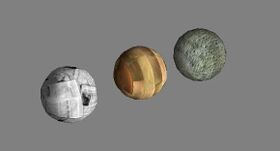“Prop ball”的版本间的差异
Speedystoneball(讨论 | 贡献) (创建页面,内容为“{{Languages|zh|道具球}} {{Distinguish|This article is about the '''Prop Ball''' which is not directly controlled by the player. See '''ball''' for the balls t…”) |
Speedystoneball(讨论 | 贡献) 小 |
||
| 第59行: | 第59行: | ||
|- | |- | ||
!scope="row"| Prop paper ball | !scope="row"| Prop paper ball | ||
| − | | | + | | Mean 4.0, maximum 5.0 |
| 0.5 | | 0.5 | ||
| 0.4 | | 0.4 | ||
| 第95行: | 第95行: | ||
|- | |- | ||
!scope="row"| paper ball | !scope="row"| paper ball | ||
| − | | | + | | Mean 4.0, maximum 5.0 |
| 0.5 | | 0.5 | ||
| 0.4 | | 0.4 | ||
2023年5月18日 (四) 15:21的最新版本
| Chinese version / 中文版: | 道具球 |
|---|
This article is about the Prop Ball which is not directly controlled by the player. See ball for the balls that players can directly control. |
Prop balls, are balls that appears as objects and cannot be directly controlled by the player.
Introduction
The prop ball is almost identical to the player ball in appearance, but there are differences in physical properties. Specifically in:
- The prop balls will appear or disappear according to the section it is in (the basic nature of objects).
- The prop balls will not trigger checkpoints, balloons, or transformer.
- The prop balls cannot be blown up by a ventilator, no matter what kind of prop ball it is, or how many fans are stacked.
- Part of the physical parameter data of the prop ball is different from that of the player ball.
- The prop stone ball cannot break suspension bridge.
- Prop stone balls are actually a bit shinier than player stone balls, but the textures are exactly the same.
- Prop balls do not produce shadows.
Purpose
The prop wooden and paper balls can be used as obstacles to block the player's paper balls and wooden balls; they can be used as props for paving the way like boxes; or just as decorations.
The use of prop stone balls is more extensive. Combined with favorable terrain, it can easily block the player's paper balls and wooden balls, and a slightly larger number can block the player's stone balls; it can also be used as a road pad or as a decoration; it can even be used as a very dangerous aggressive trap, such as in level 4 section 3. But the use is more to use them to push away obstacles in positions that are difficult for player balls to reach.
Physical parameters
The physical properties of the three prop balls are given below (the orange and bold are different from the player ball):
| object | hitbox diameter (m) | friction | flex | mass/ton | linear damping | rotation damping |
|---|---|---|---|---|---|---|
| Prop stone ball | 4.0 | 0.7 | 0.1 | 10.0 | 0.2 | 0.1 |
| Prop wooden ball | 4.0 | 0.6 | 0.2 | 2.0 | 0.6 | 0.1 |
| Prop paper ball | Mean 4.0, maximum 5.0 | 0.5 | 0.4 | 0.2 | 1.5 | 0.1 |
For comparison, the physical parameters of the part of Player Ball are given below for reference:
| object | hitbox diameter (m) | friction | flex | mass/ton | linear damping | rotation damping |
|---|---|---|---|---|---|---|
| stone ball | 4.0 | 0.5 | 0.1 | 10.0 | 0.3 | 0.1 |
| wooden ball | 4.0 | 0.8 | 0.2 | 1.9 | 0.9 | 0.1 |
| paper ball | Mean 4.0, maximum 5.0 | 0.5 | 0.4 | 0.2 | 1.5 | 0.1 |
Did you know
- After pushing down the prop wooden ball at the end of the level 1 section 1, after entering the second section and returning, it was found that the prop wooden ball did not disappear. This is because there is a new prop wooden ball at the same position in the second measure, creating a feeling of "the ball has passed the measure but has not disappeared" (if this wooden ball wasn't there, then falling in that hole would be a non possum mori )
- At the beginning of the level 13 section 2, there is a new stone ball under the checkpoint, which just connects with the prop stone ball in the first section, and also creates an effect where the prop ball does not disappear.
- Players can try to deliberately push the prop ball into balloon, but after that, they generally cannot push the prop ball away by normal means, nor can they trigger a pass. This state may also cause the spacecraft's balloon to jerk.
